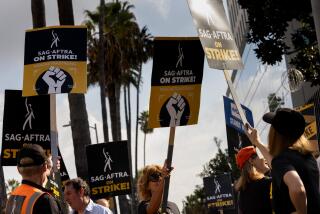DGA as peacemaker
The studios and the Directors Guild started talking Saturday -- the day before the Golden Globes’ televised implosion into a hurried news conference -- and some people think an agreement is imminent, if for no other reason than the hope that the Oscars can be saved from a similar fate. But a quick deal for directors may not signal progress on Hollywood’s larger labor issue, the Writer’s Guild strike that is dragging down the industry and local economy.
All three guilds -- the writers, actors and directors -- are focused on new-media residuals, which are reuse fees paid when a movie or TV episode is streamed or downloaded from the Internet. The studios have so far offered writers peanuts -- for instance, just $139 for a year of streaming a half-hour TV program, no matter how much ad revenue it generates. The Writers Guild is demanding about eight to 10 times that amount. Will the Directors Guild take a similarly tough stance? Probably not. But it should.
The Directors Guild cares about new-media residuals -- it reportedly spent almost $2 million researching the issues -- just not as deeply as writers or actors do. The top echelon of movie directors are paid millions and promised a cut of the gross, so new-media residuals don’t amount to much mad money for them. Meanwhile, 40% of DGA members are assistant directors and unit production managers who receive practically no residuals now.
As a result, the Directors Guild likely is more willing to trade off new-media residuals against other issues, such as larger base payments up front. Indeed, the studios would prefer to hike those minimums rather than increase residuals. That’s because the first residuals deal negotiated often becomes a blueprint for the others -- it’s called “pattern bargaining” -- but upfront minimums don’t work that way. If the directors’ deal were to become the contract template, each dollar of residuals the studios grant multiplies into more than $12 across all the unions’ contracts.
What about the actors? So far, the Screen Actors Guild has stood firm with the writers. Normally, though, SAG conducts its studio negotiations in tandem with a less-assertive actors union, the American Federation of Television and Radio Artists. But this time around may be different: SAG will vote next month on severing that joint-bargaining relationship. That’s an ominous sign; it means SAG wants the freedom to take as hard a line as possible this year.
So the stage is set for a disaster. If the directors accept a lowball new-media deal, the Writers Guild and SAG may well reject it as a template, and pattern bargaining would break down. SAG’s position would embolden the Writers Guild leadership to maintain the strike, despite pressure from some writers to end the walkout. Come June 30, when the actors deal expires, SAG would go on strike too.
At that point, the industry would be in all-out civil war, with battle lines drawn: the writers and SAG on one side, and studios, networks, directors, crew and AFTRA on the other. Feature film production would cease, just as scripted TV production already has, but studios and networks would limp along for a while on a diet of reality TV and movies already in the can. The two strikes could stretch on for months longer.
In this scenario, everyone suffers, including the directors. If there are no scripts and no actors, there’s nothing to direct. More people would lose their jobs, and bitterness would increase dramatically, making it ever harder to hammer out new contracts.
There’s an obvious way to avert this scorched-earth scenario: The directors have to insist on a deal that the writers and actors can live with, even to the point of threatening a strike of their own. That’s a tough script to follow: It’s hard to negotiate on someone else’s behalf, and strikes are alien to the directors (they’ve only walked out once in seven decades, and that was for just five minutes).
But if the DGA negotiators pull it off, pieces start to fall into place. A good directors deal gives the writers and studios incentive to restart their own talks, which ended five weeks ago when the studios walked out. They could then close a deal on new media on the same terms as the directors, ending the strike. SAG would presumably do a similar deal, without ever striking.
A movie set is a tough place; a cast and crew of hundreds depend on the director to keep the show moving. This time, though, the “cast and crew” number in the tens of thousands, and millions more people are watching. The stakes are high. Let’s hope the directors don’t yell “Cut!” too quickly.
More to Read
The biggest entertainment stories
Get our big stories about Hollywood, film, television, music, arts, culture and more right in your inbox as soon as they publish.
You may occasionally receive promotional content from the Los Angeles Times.










